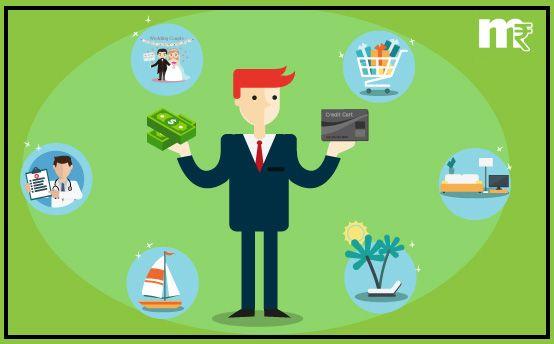When in Need Turn to – Personal Loan or Credit Card?
At times in life, most of us are faced with a sudden requirement of extra funds, over and above day to day fund flows. At such times, one turns to avenues which are close at hand, which could range from borrowing from friends, family or taking a personal loan or leveraging a credit card.
While such options definitely provide recourse to the much needed short term fund, but a prudent borrower should be aware of the obligations attached to each choice. This article attempts to highlight some such aspects pertaining to choice between instruments like personal loan and credit cards. In order to understand this, it is important to first understand the typical terms of Use of Personal Loans and credit cards.
A Personal Loan is an unsecured loan given to customers on pre-set criterion by lenders typically including income base, type of employment, work experience and credit history. Usually such loans are used to meet personal needs as well as addressing sudden and unexpected expenses. Typically such loans are available between a range of 11.49% to 17.5 % from a variety of lenders and the tenure of the same can vary between 1 to a maximum of 7 years. The loan is expected to be repaid through equated monthly instalments (EMI’s) throughout the loan period but options of pre-payment are also possible subject to pre-payment terms & conditions.
On the other hand, as is well known, a Credit Card is a financial card issued by a bank or an issuer which has a pre-defined credit line based typically on a person’s income, credit score and ability to repay. Usually, credit cards are used in wide range of merchant establishments, as a mode of payment, including retail stores, gas stations, restaurants, hotels, hospitals among others. Whilst expenses are permitted till the pre-set credit limit, the repayment on expenses needs to made periodically, in part or full within the set credit cycle. If the payment is made within the monthly repayment date, usually there is no interest. However, if there is an unpaid outstanding, a very high interest kicks in on the same, which can grow exponentially.
In order to illustrate the fundamental differences between these two instruments, a hypothetical example below may be useful:
| Credit Card | Personal Loan | |
| Outstanding | 1 Lakh | 1 Lakh |
| Tenure | 60 Months | 60 Months |
| Interest Rate | 39% per annum | 12.5% per annum |
| Monthly Repayment | 5% of Outstanding (minimum dues) | 2250 approx.(EMI) |
| Total Repayment | 1.79 Lakhs | 1.35 Lakhs |
| Balance Outstanding | 31,392 | NIL |
Example Assumptions:-
In the above example, it is assumed that the customer pays mandatory dues both on Credit Card and Personal Loan. Both the payments are built with a 5 year tenor, where customer is charged interest on a monthly basis. Residual principal is zeroed in a Personal Loan but continues on a Credit Card.
It is quite evident from the table above that, for this example, the total payout on Credit Card debt is substantially higher than that of a Personal Loan – given the same loan amount and tenure, the difference being clearly attributable to the higher credit card interest rate and the fact that the principal outstanding keeps on increasing on unpaid dues in case of a Credit Card.
Despite the fact that both personal loans as well as credit cards are easy to avail, a personal loan usually allows one to plan a medium term EMI regularity by which they can plan their incomes and expenses accordingly and ultimately have zero outstanding. However, on the other hand a Credit Card Loan or outstanding if not paid in time and in sufficient amount, may start exponentially increasing both in terms of amounts payable and undefined tenures of repayment.
Hence, one should always weigh the pros and cons of going in for either of these instruments and match one’s own financial objectives and repayment potential with regard to the financial terms of respective instruments.
Also Read: Is it Possible to Get a Personal Loan if You Have Defaulted on a Loan?
